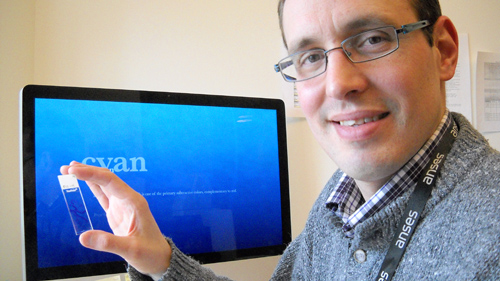
One sign that Brandon Plattner had landed in a new place came during his first week at Guelph in early 2011. Well, two signs – both down in the post-mortem room in U of G’s Pathobiology/Animal Health Laboratory (AHL) Building.
“I realized there was both a polar bear and a moose at the same time. Wow, we’re not in Kansas anymore,” says the pathobiology professor.
He hadn’t encountered either creature in his Midwest home state. Dairy cattle were more common in the northeast corner of Kansas where Plattner grew up on a hobby farm, just across the border from Nebraska.
By his mid-teens, he’d already milked plenty of those cattle, mostly on an uncle’s farm. For payment, his uncle gave him a calf, and then another one, and then another. By high school, Plattner had amassed his own herd of about 10 Holstein crosses and had plans to become a dairy farmer. “My favourite animal to work on was cattle.”
His father talked him out of that plan. Too expensive, said Dad.
Instead, Brandon raised his cows for a different purpose. When he sold them, he says, “They helped fund my veterinary education.”
Plattner finished veterinary school at Kansas State University in 2002. He worked in a mixed practice back home before deciding to pursue a residency and grad studies in anatomic pathology at Iowa State University.
It was there that he got interested in Johne’s disease, a chronic wasting ailment in cattle, sheep and other ruminants. The bacterial infection affects herds all over the world and costs millions of dollars in treatment and loss of milk and animals.
The disease causes inflammation of the intestinal tract, leading to severe weight loss and diarrhea, as well as reduced milk production.
It’s hard to detect in calves and may take two to five years to show up. Some animals probably clear the infection, he says, but many do not. There is no cure.
“The missing link has been the ability to recognize what’s happening in the first few years,” he says.
Plattner is particularly interested in animals’ immune response. At Iowa State, his adviser, Jesse Hostetter, had developed a model for immunity studies.
Now at Guelph, Plattner is still looking at why certain animals succumb to the infection and how the disease progresses in different animals. Ideally, he says, researchers would develop a handy diagnostic test to help farmers and practitioners pinpoint the disease earlier.
After finishing his PhD in 2010, he had spotted an opening at the University of Guelph.
“I didn’t know where Guelph was. What’s Guelph?” he says.
Only the oldest veterinary school in North America, he soon learned. There were other drawing cards – although many of those became apparent only after he’d nearly talked himself out of coming at all.
He had spent the flight here scrawling pros and cons on a notepad. The list weighed heavily against moving to Canada. “By the time the flight landed in Toronto, I had four pages of reasons.”
One key reason involved family – not just his own but that of his wife, Rhoda. For both sides, all of their family members lived within about 20 miles of each other around two small towns north of Topeka, including Bern – population: about 250. “Guelph is the biggest city I’ve ever lived in.”
Once on campus, he found plenty of things to fill out the other side of his list. A key draw was that new Pathobiology/AHL Building, which would open later that year. The 126,000-square-foot building serves as a hub for investigating disease and solving animal and public health problems.
About one-third of its space is devoted to the AHL, which provides diagnostic services for veterinarians and various clients as part of the Ontario Animal Health Surveillance Network with the Ontario Ministry of Agriculture and Food.
From his third-floor office, Plattner heads downstairs often to teach in the post-mortem room and at the microscope. He spends about half of his time teaching veterinary and grad students looking to sharpen their skills in surgical pathology and diagnostics.
Those students get a good look at animals arriving for post-mortem exams, including routine and not-so-routine cases.
Beyond moose and polar bears, that involves other wildlife and birds. It also includes small animals from the Ontario Veterinary College (OVC) Health Sciences Centre, and food animals sent from farms and field service veterinarians. “Every day I see something I never saw before.”
With OVC serving as a referral centre, he adds, “We tend to get the less common things.”
On the research side, he has connected with dairy researchers in both OVC and the Ontario Agricultural College, including Profs. Todd Duffield and David Kelton, Population Medicine; and Prof. Niel Karrow, Animal and Poultry Science. He’s also found common ground with Prof. Lucy Mutharia, Molecular and Cellular Biology, who has long studied Johne’s disease.
Plattner now lives in Guelph with Rhoda and their three children: Mason, 8, Mischa, 5, and Malia, 3.